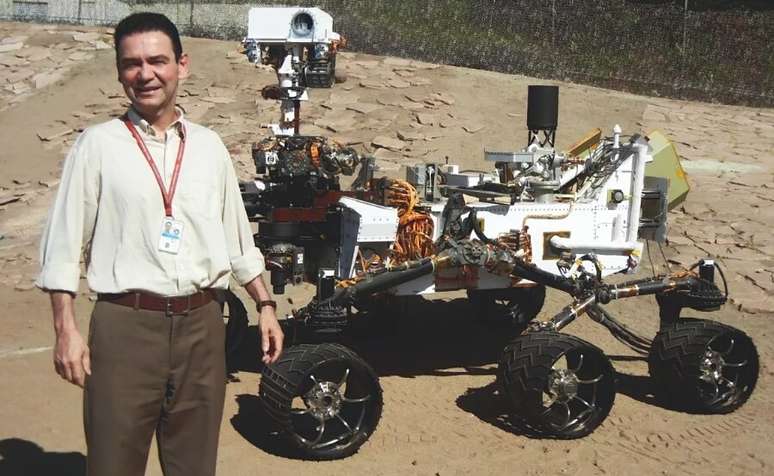If you think that there are territories and objectives that are too far away to reach, it’s because you don’t know Ivair, from Minas Gerais.
As a good miner who knows how to tell stories, the kind we can spend hours listening to around a campfire, Ivair Gontijo told me that, initially, he wanted his book to be titled “Tango Delta Nominal”.
This is why, on the night of August 5, 2012, these were the words that everyone was waiting to hear inside JPL, NASA’s Jet Propulsion Laboratory, in California, where the Brazilian engineer works. The code indicated the successful landing of the Curiosity rover on the planet Mars.
“Tango Delta Nominal,” was the announcement from the control room. It was the operation of the most complex robotic vehicle ever launched into another world. Ivair, responsible for building the heart of the radar used in Curiosity’s descent to the red planet, says that “you have to be very optimistic to think that an agreement like this will work.”
Different worlds
It turns out that this wasn’t Ivair’s first trip to other worlds. He was born in Moema, a town in the interior of Minas, where the São Francisco river also originates. An earth that seems to contain within it several planets, some even similar to the Moon, you see. I saw.
From there, he traveled to major universities around the world. He settled in the United States. He enrolled at NASA. He discovered that he could, together with many other optimistic people like him, bring humanity to Mars. I took Curiosity to the red planet.
Then Perseverance, a rover that landed there in 2020. It saw the first photos of the Martian terrain – today we can all see them too. He believes he will be alive to see man land on Mars.
In a cold, empty room at São Paulo’s WTC convention center, where he spoke to more than 500 businesspeople and technology professionals during ScanSource Brasil’s Elite Partner Conference event, I interviewed Ivair in a conversation that it lasted a little longer. minutes. This is what the recording on my computer showed me later. But he wasn’t in a hurry. It also didn’t cross my mind to keep it there longer, just to gain minutes and characters. He had already told me so much that I wanted to absorb it all.
Ultimately, Ivair’s book, a biography mixed with fascinating scientific work, was published under the title “On the Road to Mars: The Incredible Journey of a Brazilian Scientist at NASA.” Not bad either. Indeed, it is not every day that an engineer, physicist and scientist wins a literary award: the Jabuti prize, in 2019.
There are so many worlds that Ivair Gontijo can see that it almost makes his head spin. Almost. It is because he knows how to talk about all of them in such a way that we too can perceive them, as if they were there, within our reach. I am?
A chat with Ivair
You came to Brazil to give a conference in front of an audience of business people. What does a NASA scientist have to do with the corporate world?
Brazil has engineers and scientists that are unrivaled in the rest of the world. These engineers who work in Brazilian companies have the right to feel proud of the work they do and we must show it. The Brazilian engineer is good and works very well.
You’re not unique, you say, right?
Certainly at the NASA center where I work there are at least 20 Brazilians, they are all very good. And I think it’s important to show and tell people about science and technology. It’s something that always excites me to talk to any audience.
Is there also the fact that space exploration attracts everyone?
In any field of knowledge and business, people have a deep connection with space, with the universe. Astronomy was the first science to be invented. Everyone has this connection.
Do you think this curiosity about space is natural for humans?
There are also those who say that, look, we are the conscious part of the universe that looks at itself. Imagine that the hemoglobin molecule, which is found here in our blood, contains iron, and this iron was synthesized in the core of a star that exploded in this nearby region and which much later gave rise to our Sun. So, we are stardust, but conscious. There is this deep connection, yes.
High investments combined with very high risks: it’s an explosive combination. There’s a lot of money, but there’s also a lot of things that can go wrong with these missions that you work on. Do you feel this pressure, or anxiety, because you have so much responsibility in your hands?
Naturally, everyone working on these missions is under enormous pressure. And there are also deadlines. We depend on the alignment of the planets to launch a mission, and if you don’t launch a mission to Mars on the correct date, it won’t be until 26 months later that you can do it again. This has consequences. When the Curiosity mission wasn’t ready on time – it was supposed to be sent in 2009 and launched in 2011 – it cost another $400 million. There’s enormous pressure to get things done on time, but we won’t even launch a mission if there’s a big risk of not knowing whether what we did was right or not. It won’t be released if we can’t test it.
It’s like a plane taking off, right? Take off only if you are sure that everything has been done correctly.
Exactly. If you haven’t done absolutely everything to make it work, it’s best not to start it.
Can this caution be a valid principle for those who make business decisions?
It depends on the level of risk that each person and each company is willing to take. There are some things worth taking more risks for, so much so that NASA has different mission levels. This type of mission to Mars is one of the most expensive, so we want to reduce risks and ensure that everything is done to be successful. But there are many other much cheaper missions where there is much more risk involved, for example a satellite entering Earth orbit to carry out a very specific climate study. If it goes wrong, the cost will not be very high, so you can take more risks. It’s always this game between risk and cost.
What do you work for? What do you want to see as a result of what you do?
One of humanity’s biggest questions is: did life also form on Mars? Because all the evidence we have is that the planet, three or three and a half billion years ago, was very similar to Earth. There was liquid water, there was organic material, there were rivers flowing there, so it certainly rained a lot on Mars, in very distant days. At this time, life was forming here on Earth. Did you graduate there too? If it was formed, who knows, who knows, will we discover it in these samples that we will report in 10 years? [Em referência à missão Mars Sample Return, que pretende trazer à Terra as primeiras amostras de material geológico do planeta vermelho] And if you didn’t graduate, why not? Why is Earth so different? So, these big questions that humanity has always had are the main reasons why we do this. Answer this kind of thing. Are we alone in the universe? Because life must have originated somewhere first. We may have been the first. It could also be the opposite, that we are all Martians, that life formed there, that an asteroid collided with Mars and formed a huge crater, that Martian rocks arrived on Earth bringing life with them and fell here.
This is also a theory, right?
The panspermia theory. What if life developed here? It could be that too, we don’t know. Imagine if we discovered bacteria or some other life form that had DNA exactly like ours, with the same type of amino acids, and it wasn’t contamination that we brought to Mars on one of these missions? This would be one of humanity’s greatest discoveries.
We – you and I – may no longer be here when these questions are answered, right? Can you feel fulfilled and satisfied even with this possibility?
I like to play with a story that I also tell in my book. When we were building Curiosity’s radar, everything was behind schedule, and I went to a machine shop near San José, San Francisco. I told them: look, in two thousand years we could have human archaeologists working on Mars and they will discover there, buried in the dunes, these ancient spaceships. And they will say: wow, how primitive it was! But these hands that built it, despite the primitive technology, knew what they were doing. It was they who took the first steps to reach the planet Mars. I think this satisfies anyone.
For you, what does a greater understanding of space teach you about life on Earth?
Life is a fragile thing, right? There are several cultures that call Earth their mother, and while we are doing what we call “terraforming” on Mars [processo de modificar um planeta para que ele tenha uma atmosfera habitável]For life to function well there, we are doing the opposite on our planet, which is becoming increasingly hostile to life. This shows how much we need to care for him.
is a journalist and writer specializing in non-fiction narrative, with a postgraduate degree in Creative Writing from the University of Berkeley, California. She is the author of three biographies of Brazilian entrepreneurs. She has collaborated with industry vehicles and mainstream media, such as Folha de S. Paulo, and was editor of CRN Brasil, one of the largest technology magazines in the world. She is a founding member of the Essense and Lightkeeper agencies, co-host of the Vale do Suplício podcast and editor of the Destino Paralelo project.
Source: Terra
Rose James is a Gossipify movie and series reviewer known for her in-depth analysis and unique perspective on the latest releases. With a background in film studies, she provides engaging and informative reviews, and keeps readers up to date with industry trends and emerging talents.






